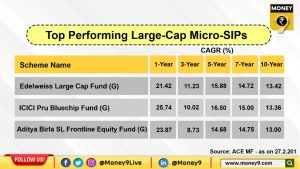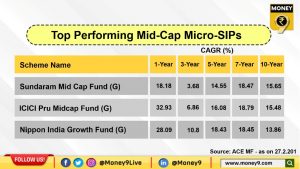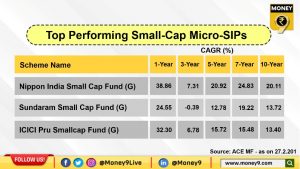A look at best-performing equity micro-SIP schemes
Rs 100 micro-SIP can fetch you Rs 3.5 lakhs in 30 years.
- Harsh Chauhan
- Last Updated : March 3, 2021, 12:35 IST

Small, yet steady and consistent measures can help attain your goals. This holds true when it comes to building an individual portfolio and attaining financial freedom.
Even a small investment of just Rs 100 every month in a micro-SIP can fetch a few lakh of rupees in the long run. Say for example you start a monthly SIP of Rs 100. In a year, you will have contributed Rs 1,200. In 20 years, this amount will be Rs 24,000. If you assume a 12% return per annum, this amount will become Rs 98,925. At the end of 30 years, it would be about Rs 3.5 lakh. And in 50 years, Rs 39 lakh.
Micro SIP demystified
Micro-SIPs are a small amount of investment plans. A Systematic Investment Plan is a highly popular facility offered by mutual funds where you can automatically invest a fixed sum of money in a mutual fund at pre-specified intervals of time (weekly, monthly, etc.) by giving a one-time instruction. Just like a Recurring Deposit (RDs), SIPs help you invest regularly and with discipline.
Systematic investment plans that allow you to invest Rs 100 to Rs 500 are called Micro-SIPs. Micro SIPs are meant for those who do not have a huge surplus to invest in. It is useful for low-income earners, students who receive pocket money and even children. Because it is not very difficult to save Rs 100 every month. Micro-SIPs can help individuals accumulate a corpus without stretching one’s finances. It also offers a modest start to an individual cycle of saving and investing.
Let us look at which are the best performing equity micro-SIP schemes. Equity funds are broadly classified into three broad categories viz. Large-Cap, Mid-Cap & Small-Cap
Large-cap funds
Large-cap mutual funds are equity funds that invest primarily in the top 100 companies of India. These companies are some of the biggest brands in our country, and most Indians use their products daily. So here are the top three large-cap schemes that allow micro-SIP of Rs 100.

Mid-cap funds
Mid-cap funds are a type of equity mutual funds that invest in mid-sized companies. According to the norms, companies that are ranked from 101 onwards till 250 based on their market capitalisation, are categorized as mid-cap companies. So here are the top three mid-cap schemes that allow micro-SIP of Rs 100.

Small-cap funds
Small-cap equity funds invest in the smallest companies in India. These companies are beyond the top 250 companies and are mostly unheard of in our daily lives. While they can deliver fantastic returns, small-cap companies are incredibly volatile, and you can see losses in the short to medium term. So here are the top three small-cap schemes that allow micro-SIP of Rs 100.

The above schemes are the top three performing schemes in their respective categories based on their 10 years compounded annual growth rate (CAGR). The reason we are considering CAGR as equity investments enjoy the benefits of compounding.
Download Money9 App for the latest updates on Personal Finance.
Related
- इक्विटी म्यूचुअल फंड में निवेश मई में 21.66 प्रतिशत घटकर 19,013 करोड़ रुपये
- जियो ब्लैकरॉक म्यूचुअल फंड ने शीर्ष स्तर पर अधिकारियों की नियुक्ति की
- बाजार के उतार-चढ़ाव में भी आब्रिट्राज फंडों ने दिया एफडी से ज्यादा रिटर्न
- इन 5 म्यूचुअल फंड्स ने 5 साल में दिया 20 फीसदी से ज्यादा का रिटर्न
- ये हैं टॉप 10 लार्ज कैप म्यूचुअल फंड, जिन्होंने दिया है 10 फीसदी से ज्यादा का रिटर्न
- ये हैं बंपर रिटर्न देने वाली टॉप म्यूचुअल फंड स्कीम, अकेले इस मिडकैप ने 12 महीने में दिया 57 फीसदी का मुनाफा

